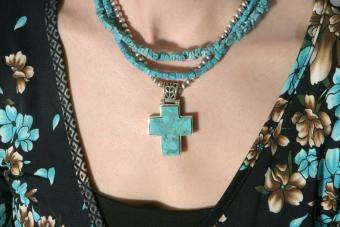
Bakelite jewelry is gorgeous, fun, and highly collectible. If you love vintage jewelry, especially items from the Art Deco period, then Bakelite jewelry will be right up your alley. Learn how to identify Bakelite, and find out which Bakelite pieces are the most valuable to collectors.
History of Bakelite as a Jewelry Material
Invented in 1907 by a chemist named Leo Baekeland, Bakelite quickly took off as a material for novelty jewelry. The industrial era was in full swing, and manufacturers could quickly and easily form this early plastic into almost any shape imaginable. This made the jewelry available to the masses, who may not have been able to afford many special items prior to its invention.
The use of Bakelite really took off in the Art Deco period, and its opaque, matte appearance went well with the clean lines and geometric styles of the era. This also encompassed the time of the Great Depression, when most people didn't have much disposable income to spend on fine jewelry. Bakelite was affordable and gave women of the period a chance to show off their personal style. Most production stopped in the early 1940s around the time World War II started.
Bakelite Jewelry Colors
You'll find just about every type of jewelry made out of Bakelite. It came in several colors, including red, green, brown, blue, black, and white. Some of these colors have changed over time as the chemicals in the Bakelite react with the air. For example, items that were once white sometimes appear a yellowish brown, and blue-toned pieces are now green. Some rare Bakelite colors were translucent. Clear red Bakelite is some of the most desirable to collectors.

Styles of Bakelite Jewelry
Manufacturers of the era created some incredible designs with this early plastic, and there are lots of Bakelite pieces that are just as wearable today as they were in the early 20th century. You can find many of these pieces online or in antique stores:
- Bakelite bracelets - These came in solid bangle styles, as well as linked designs. They are sturdy and wearable today.
- Necklaces - You'll see all kinds of styles on the secondary market, including strings of chunky beads, thick chokers, and molded or carved pendants.
- Pins and brooches - From adorable and funky animal shapes to flowers, there are tons of designs. Some even feature rhinestones set in the Bakelite.
- Earrings - Often featuring a clip back, Bakelite earrings were heavy and substantial. Look for hoops and geometric shapes.
- Bakelite lockets - A bit harder to find than some other items, Bakelite lockets often featured a cameo design.
- Rings - Usually formed out of a single piece of Bakelite, these rings are chunky and may not be especially comfortable. They can't be resized, so it's important to get the correct size when shopping.
Genuine Bakelite Identification
So you've found a piece of vintage plastic jewelry in a store or auction. How can you tell if it's Bakelite? There are a few tests you can use to tell whether it's vintage Bakelite jewelry or some other form of plastic that may not be as desirable.
Chemical Testing for Bakelite
You can identify Bakelite by using a product called Simichrome Polish. Simichrome is a metal polish you can buy in household stores or on Amazon. Here's how you can use it to test for Bakelite:
- Put a small amount of Simichrome polish on a white rag or cotton swab.
- Rub the Simichrome on the item in an inconspicuous spot for about 30 seconds.
- Look at the rag or cotton swab. If it has an ivory or yellow smear on it, the item is probably Bakelite.
Heat Testing for Bakelite
When Bakelite is exposed to heat, it can give off a smell similar to formaldehyde. Never touch a Bakelite piece directly to something hot, and don't expose it to an open flame. Instead, you can run bangles and sealed pieces without added stones or strings under hot running water for 30 seconds. For items that have stones, metal, strings, or lots of delicate detail, you can use a hair dryer to gently heat the piece. Once it's warm, sniff it to see if you recognize the smell of formaldehyde.
Value of Bakelite Jewelry Pieces
No matter what type of piece you have, genuine Bakelite jewelry is worth money. Many simple necklaces and bracelets sell for $100 or less, but more elaborate designs with multiple colors or intricate carving can sell for hundreds or even thousands of dollars. A simple bangle bracelet without a lot of carving or embellishment can be had for only about $30, and it's also easy to find basic earrings or pins in the range.

Factors Affecting Bakelite Values
Several factors can affect the value of vintage jewelry, especially a piece of Bakelite jewelry:
- Design - Some of the most valuable pieces include those that are carved, painted, or laminated. Multi-colored items featuring more than one shade of Bakelite are also considered valuable, vintage costume jewelry.
- Vintage charm - Certain motifs, such as bird-shaped pins or beautiful florals, make such a lovely, unique style statement that they are in high demand. Polka dot patterns are also a hit with collectors.
- Condition - Bakelite is sturdy and generally holds up well to time. However, scratches, cracks, chips, and scuffs will negatively affect value. Missing hardware is also a problem, so check for original pin and earring backs and necklace clasps.
- Wearability - Certain items are easier to wear today than others. For instance, Bakelite shoe clips, which went on the front of pumps to dress them up, are not as easy for today's collector to wear. However, a strand of beads or a lovely bracelet works just as well today as it did 80 years ago.
- Color rarity - Some rare Bakelite colors can be extremely valuable. For example, turquoise Bakelite often takes on a greenish hue over time, so actual turquoise colored pieces fetch top dollar. Similarly, translucent colors are often worth the most.
Example Bakelite Jewelry Values
Rarity and desirability are some of the reasons Bakelite is so expensive. It's also highly collectible. If you have a piece of Bakelite jewelry and are wondering how much it's worth, it's a good idea to compare it to recently sold items in a similar style. There's a wide range of value when it comes to Bakelite, as the following examples show:
- A large strands of red Bakelite beads can fetch $4,000 or more and are among the most valuable items to collectors, likely because the cherry amber color is fairly rare and the simple design is very wearable.
- A multicolored Bakelite bracelet valued at over $2,700 is worth so much because of its rarity, vintage charm, and condition. It features several different colors of Bakelite in a single piece, and it has a distinctive Art Deco style.
- Simpler designs that don't feature rare Bakelite colors or styles are not worth quite as much. For instance, an apple juice-colored Bakelite bead necklace with a simple design sold for about $100.
Caring for Bakelite Jewelry
Because vintage Bakelite jewelry is valuable and represents an era in fashion history, properly caring for it is important. How you clean Bakelite and how you store it can help preserve its value.

How to Clean Bakelite
Over time, Bakelite develops a patina as the chemicals in the plastic react with the air and surrounding environment. This patina is part of its beauty, so it's important to clean Bakelite jewelry carefully.
- Use a gentle dish soap and warm water to make a weak soap solution.
- Gently wash the jewelry. If the piece is solid, such as a bangle bracelet, you can soak it in the soapy water for about half an hour. If it's not solid, use a cotton cloth dipped in the soapy water to remove any grime or dirt.
- Rinse the Bakelite jewelry thoroughly. If it's solid, you can rinse it under running water. If not, dip a soft cloth in clean water and wipe off the soap.
- Carefully dry the Bakelite with a clean cotton cloth. Leave it to air dry if there are crevices you can't reach with the cloth.
How to Store Bakelite Jewelry
Storing Bakelite jewelry properly is important. Keep these tips in mind:
- Control temperature as much as possible. Dramatic temperature fluctuations can damage early plastics. Keep your Bakelite jewelry inside your home or in a temperature-controlled space.
- Avoid bright sunlight. Sun can cause Bakelite and other early plastics to fade or become brittle. Keep your jewelry in a closed container that doesn't allow direct sunlight to hit the pieces.
- Keep Bakelite dry when storing it. Moisture can cause metal pieces in your jewelry to rust or corrode, and it can damage strings on beaded necklaces and bracelets.
A Piece of History
No matter what style or color of Bakelite jewelry you choose to collect, it's fun to know you're wearing a piece of history. Each item has a story and has been loved by generations before you. Just like with other vintage costume jewelry, this retro appeal is part of what makes Bakelite jewelry turn heads.







